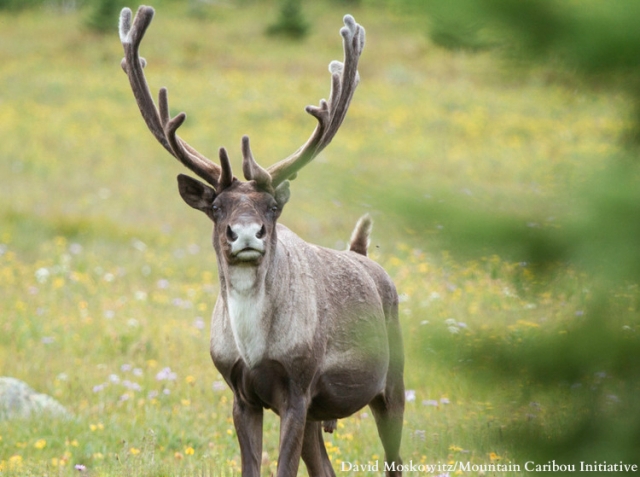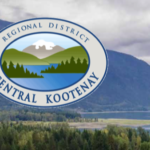Caribou, Logging, Wolves and Corporate Donors
What poses the greatest hazard to BC's endangered Southern Mountain Caribou — habitat loss, wolves, or corporate donors? Or are all three of those factors linked, and if so, how? This opinion piece is from DeSmog Canada. Read and contemplate.
The B.C. government is granting logging permits in critical caribou habitat, despite evidence that B.C.’s Southern Mountain Caribou are being driven to extinction by habitat loss — a move that has driven citizens to call on the federal government to enforce the Species At Risk Act.
Among the hardest hit regions in the province is the area in and around Wells Gray Park, the scenic home to Helmcken Falls, two hours north of Kamloops.
There, people like Trevor Goward, a longtime local resident, naturalist and professional lichenologist, are sounding the alarm over the province’s failure to protect caribou.
Goward, along with a group of local citizens, is currently preparing to file with the federal government for an emergency stop to a fresh round of clearcuts in the Upper Clearwater Valley, which lies just outside of the southern boundaries of Wells Gray Park.
Canfor has obtained permits to log blocks W101 and W102 on the west side of the Clearwater River, and block T121 on the east side — all designated critical habitat for caribou. The company is sitting on nine more blocks on the east side, covering hundreds of hectares, and has indicated imminent plans to file for a number of additional permits there.
Canfor and its subsidiaries have donated a total of $884,366.08 to the BC Liberals since 2005, according to data released by Elections BC and the BC Liberals. The Council of Forest Industries, of which Canfor is a member, has donated an additional $54,815.00.
Canfor did not respond to a request for comment.

Image: Trevor Goward and Jason Hollinger
In filing their petition, Goward and his group are essentially going over the head of the province, which has jurisdiction over logging and caribou management, but not over endangered species. That constitutional responsibility for endangered species falls to the federal government, under the Species at Risk Act (SARA).
The Southern Mountain Caribou were listed as “threatened” when SARA was created in 2002. Then in 2014, they were designated as “endangered” by the Committee on the Status of Endangered Wildlife in Canada.
“The province of B.C. has utterly failed to prevent logging in areas outside the Wells Gray Park where logging boosts deer and moose populations and artificially increases the number of wolves that then prey on caribou,” explains Bill Andrews, lawyer for Goward’s petition group.
A major point of divergence between the province and federal government’s approach to endangered Southern Mountain Caribou is in the treatment of “matrix habitat” — areas where caribou may not necessarily roam, but, because they are adjacent to other critical habitat, are nevertheless important to the caribou’s survival.
When matrix areas are clearcut, they attract and sustain predators, including wolves which can travel up to 100 kilometres per day — yet the B.C. government does not prevent logging in these areas, restricting industry only in those it narrowly defines as “core habitat.”
The new Canfor cutblocks fall directly within what is considered Type 2 Matrix habitat by the Species At Risk Act, meaning it should be kept relatively free of predators
“The federal government has constitutional authority to step in and protect the critical habitat of an endangered species where the province is unwilling to do so,” Andrews says.
“My clients are petitioning federal minister of environment Catherine McKenna to do just that.”
Caribou's True Culprit: Habitat Destruction
While the province of B.C. has placed much of the blame for disappearing caribou on wolves, a closer look reveals the real culprit: decades of habitat loss from various forms of industry and, most notably, landmark changes to B.C.’s logging regulations under the 16-year tenure of the B.C. Liberal government.
Goward has produced a graph that lays key policy and legislative changes over declining caribou populations, revealing a stark parallel.
In 2004, the B.C. Liberals switched to the Forest and Range Practices Act, which essentially deregulated the forestry sector and put logging companies in charge of policing their own operations. As a 2011 B.C. Government and Service Employees’ Union report, “B.C. Forests in Crisis,” put it:
“Under FRPA, industry was given control over its operations, and entrusted to achieve on-the-ground results with less government supervision. Industry was allowed to define its own ‘results,’ as long as the results were consistent with general government objectives, and forest professionals would be relied upon to ensure sustainable practices (called “professional reliance”)…These policy changes significantly reduced the role of government in the forest industry. Direct government involvement in on-the-ground forest management was seriously limited, and key levers to influence industry activities were removed.”
These regulatory changes ushered in a series of devastating clearcuts throughout the Wells Gray region and all around the province.

Image: Trevor Goward and Jason Hollinger
In February, the B.C. government issued an election-time announcement, committing $27 million toward caribou recovery efforts. But the announcement downplayed a dramatic reduction in caribou numbers and plans to expand the province’s controversial wolf cull program to new caribou regions.
“It’s a policy to influence politics,” Chris Darimont, Hakai-Raincoast professor at the University of Victoria, says. “The province needs to be recognized for 'doing something'. And despite the controversy about wolf control now, it’s easier politically than halting industry where endangered caribou roam.”
Christy Clark’s Caribou Numbers Game
In its February announcement, the B.C. government released population figures for the total of B.C.’s woodland population herds — numbers that mask precipitous declines in specific herds.
“Today there are some 19,000 caribou in the province, compared to between 30,000 and 40,000 at the turn of the last century,” the press release states. Yet only around 1,300 Southern Mountain Caribou remain across the province and many herds — including the Northern Woodland Caribou in the Peace region — are now endangered or even extirpated (locally extinct).
All of B.C.’s caribou are of the woodland variety, but there are different subpopulations within that.
South of Prince George roams a unique variety known as mountain or “deep snow” caribou. What makes the Southern Mountain Caribou special is their wintertime vertical migration into the high country. Their saucer-like hooves enable them to walk on top of 3-meter deep snow into alpine and sub-alpine habitat, where they evade predators like wolves and cougars and feed on black hair lichens which hang in abundance from the branches of spruce and fir.
It is the Southern Mountain Caribou that has experts worried the animal is being ignored by the B.C. Government.
The South Columbia herd around Mount Revelstoke, for example, has fallen from 120 animals in 1994 to just four in the 2016 census.
The Monsahee herd was recently classified as extirpated — meaning locally extinct — with just one very lonely animal noted in the census.
The province’s recent announcement acknowledges the need for habitat protection but much of the program’s focus is on “predator management” — which is more or less a lovely euphemism for killing wolves — and a maternal penning program, the effectiveness of which has been questioned.
Helicopter wolf kill programs have been taking place since 2015 in the South Peace and Southern Selkirks, but this year the province has added a new one in the North Columbia, near Revelstoke.
In 2016, 163 wolves were killed by the government’s program, a doubling from the previous year.
With the addition of a third kill program in 2017, the number is expected to grow again.

Although a portion of the $27 million is specifically set aside to support wolf culls in the Southern Mountain Caribou region, the announcement emphasized recovery work for the healthier woodland caribou north of the Peace Valley and in less industrialized portions of northwest B.C. — herds that still matter to hunters, an important voter constituency for the B.C. Liberals.
A 2017 protection study from the joint Canada-British Columbia Southern Mountain Caribou (Central Group) in B.C., found more than a quarter of the $12.5 million spent on caribou recovery between 2006 and 2016 went to predator-related initiatives — half of which was spent specifically on killing wolves.
Only $168,000, or about 1.3 percent of the total, was spent on habitat management.
The Ministry of Forest, Lands and Natural Resource Operations (FLNRO) declined to provide details on how this new $27 million will be allocated, stating simply, “since the funding has just been announced, a detailed breakdown of how the funds will be spent is not yet available.”
Caribou in the Timber Sacrifice Zone
The province began the Mountain Caribou Recovery Implementation Program in 2008 — the goal of which was to return mountain caribou from the Prince George and the Omineca Mountains south to the Washington border to 1995 census levels by 2028.
Nearly halfway into that timeframe, the program has been a dismal failure.
Most notably, the province has resisted protecting caribou habitat in areas rich in timber resources.
Just 0.65 per cent of B.C.’s Timber Harvesting Land Base has been set aside for ungulate winter range — and of this amount, very little is prime habitat for caribou.
Those lands that are protected from logging are often impacted by heavy-duty snowmobiling, which carves a path for predators to access caribou in alpine habitat.

Forestry clearcuts and recreational activities create a cascading effect by stripping the landscape of old-growth and mature forests. What grows in their place is a mixture of brush and young deciduous shrubs and trees like willow, alder, and poplar — known as early seral forest.
Seral forest makes for poor caribou habitat but attracts and sustains lots of deer, moose and elk, which in turn attract predators such as wolves and cougars. Caribou often end up killed as “by-catch.”
The de facto response from the province has been to emphasize removing these predators rather than protecting caribou habitat from industry — the fundamental method of caribou recovery consistently recommended by the scientific community.
B.C. Liberals Walked Away from Local Use Plan
For Goward, however, the problem is much bigger than concerns over logging and its impact on Wells Gray’s mountain caribou.
“What we’re looking at here,” he says, “ is a breakdown of participatory democracy — a situation where the B.C. government called for, supported and signed into effect a land-use agreement with local residents — only to walk away from it a few years later.”
Goward belongs to the Upper Clearwater Referral Group, which grew out of a relatively collaborative land use visioning process with the NDP government in the mid-to-late nineties.
Recognizing local concerns over clearcuts, the government engaged with citizens to develop a local use plan under the Kamloops Land and Resource Management Plan (LRMP). The resulting agreement, called the “Guiding Principles,” was intended to achieve a lasting balance between industry and other user groups in the Upper Clearwater Valley.
In 2000, a year after the B.C. government signed onto the Guiding Principles, it convened the Referral Group, which it mandated to act as a watchdog committee to ensure the Guiding Principles agreement was respected by all parties.
While the B.C. Liberal Government of the 2000s maintained some contact with the group, it has steadily backed away from those earlier commitments and now, in 2016, has abandoned them entirely.
This left locals like Goward feeling frustrated and without a voice as new clearcuts loom over the valley.

Logging near the south end of Wells Gray Park since 1984. Image: Damien Gillis via Google Maps
Problem Widespread in B.C.
This problem is far from isolated to the Wells Gray region. It’s a pattern visible all across southern B.C.
In the Selkirk Mountains, caribou face an uphill battle too.
Like Goward, naturalists there see it as a problem of habitat destruction and are seeking to stem the decline by creating a new provincial park that would connect to other exiting ones and preserve some of the last truly intact sections of old-growth caribou habitat from clearcuts. (This is the subject of a new short documentary I directed called Primeval: Enter the Incomappleux.)
Craig Pettitt, a charter director of Valhalla Wilderness Society, based in New Denver told DeSmog Canada caribou can be pushed over the recovery threshold.
“Once these mountain caribou are wiped out, we can’t simply import woodland caribou from further north to repopulate the region,” explains Pettitt.
Previous attempts to transplant northern woodland caribou into southern mountain herds have proved an utter failure.
The issue also goes beyond any individual cut block or road to a bigger picture of repeated habitat destruction by many activities over a prolonged period.
This notion was underscored by an important 2015 paper published in the journal Biological Conservation, titled “Witnessing Extinction: Cumulative impacts across landscapes and the future loss of an evolutionarily significant unit of woodland caribou in Canada.”
“Currently, we are observing the decline, extirpation, and perhaps extinction of several evolutionarily significant units of woodland caribou (Rangifer tarandus caribou), an iconic and cultural keystone species,” the authors note, drawing on 11 years worth of data and observations on declining caribou populations.
“The cumulative impacts of multiple anthropogenic activities are now recognized as one of the most pressing problems facing the conservation and management of wildlife across North America and beyond.”
The authors look at habitat destruction through the lens of cumulative impacts — the piling on of various layers of industrial development on the natural landscape — or, as Goward’s group refers to it in a new website dedicated to raising these issues, death by a thousand (clear)cuts.
A similar situation has unfolded in B.C.’s Peace region where decades of road building, logging, mining, dams, power lines, conventional gas and fracking have heavily industrialized two thirds of the landscape, leaving little contiguous habitat for species like caribou.
While cumulative impacts are an important legal consideration in decisions on resource projects in the U.S., in Canada, they aren’t given much weight in environmental reviews, as the Joint Review Panel into Site C Dam sharply pointed out in its final report, noting “the Panel recommends that the Canadian Environmental Assessment Agency undertake, on an urgent basis, an update of its guidance on cumulative effects assessment…”

Mountain Caribou. Photo: David Moskowitz/Mountain Caribou Initiative
As conservation biologist and wolf expert Paul Paquet puts it, “A long history of shortsighted and misguided accommodation of the forest industry has conspired to deprive mountain caribou of their life requisites and placed their survival in jeopardy. Their future now depends on our repairing the environmentally destructive mistakes of the past while stopping those of the present.”
It also depends on British Columbians demanding their government put the survival of an iconic species ahead of the interests of deep-pocketed donors.


























Comments